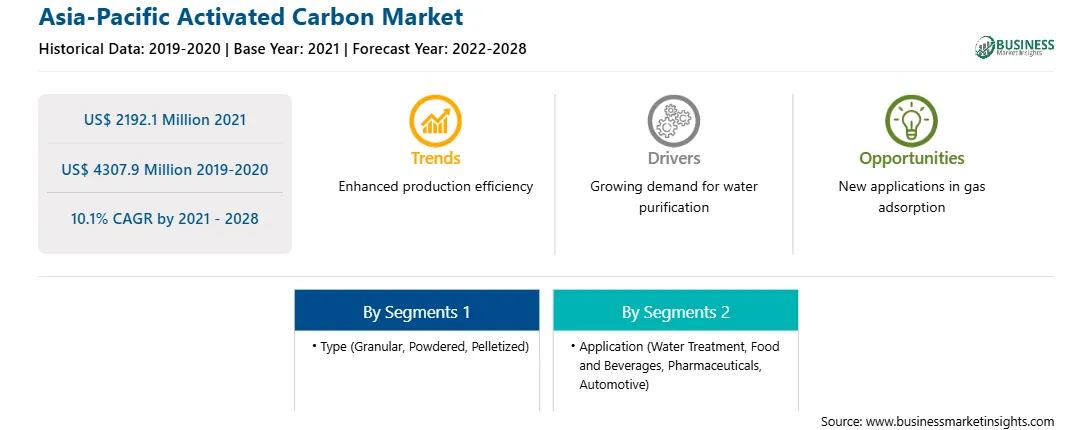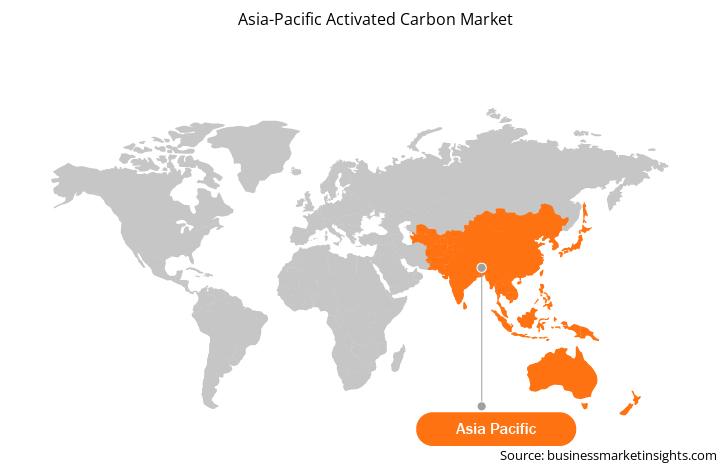Activated carbon is a highly adsorptive material used primarily in water treatment and gas & air purification applications. The material is highly versatile and useful in numerous applications across multiple industries. Activated carbon is also customized as per the specific application requirements by increasing or decreasing the porosity, subsequently changing the properties of the material. Continuous research and development activities support such wide-range applications of activated carbon, which boosts its overall demand.
In 2020, China held the largest share of the Asia-Pacific activated carbon market. China is a vigorously developing country with large-scale manufacturing and rapid-paced industrialization. The country reports high volumes of activated carbon manufacturing and consumption. The recent efforts of the country toward mitigating pollution and its harmful effects have been benefitting the activated carbon market growth. In 2015, the Chinese government announced Water Pollution Prevention and Control Action Plan to keep a check on the discharge of heavy-polluting sectors in water sources. The large-scale manufacturing results in huge volumes of wastewater, which needs to be treated using activated carbon filtration systems, which is a main factor propelling the consumption of activated carbon in China.
The COVID-19 pandemic has significantly disrupted the manufacturing sector in terms of operational efficiency owing to extended lockdown periods across different regions, restrictions imposed on international trades, shutdown of manufacturing units, prohibitions on travel activities, restrictions on supply chain, and shortage of raw materials. These consequences of the pandemic, coupled with financial instability, have hindered the activated carbon market growth in Asia-Pacific. The reallocation of resources toward healthcare consolidation has led to the lack of funds for the water supply and sanitation sector in many Asia-Pacific countries. However, with the ease of lockdown restrictions and resumption of manufacturing activities in the region, from late 2020, the activated carbon supply and demand activities are recovering at a healthy pace. The innovative applications of activated carbon, such as its use in the manufacturing of activated carbon powdered masks, are further bolstering the demand.
Strategic insights for the Asia-Pacific Activated Carbon provides data-driven analysis of the industry landscape, including current trends, key players, and regional nuances. These insights offer actionable recommendations, enabling readers to differentiate themselves from competitors by identifying untapped segments or developing unique value propositions. Leveraging data analytics, these insights help industry players anticipate the market shifts, whether investors, manufacturers, or other stakeholders. A future-oriented perspective is essential, helping stakeholders anticipate market shifts and position themselves for long-term success in this dynamic region. Ultimately, effective strategic insights empower readers to make informed decisions that drive profitability and achieve their business objectives within the market.

| Report Attribute | Details |
|---|---|
| Market size in 2021 | US$ 2192.1 Million |
| Market Size by 2028 | US$ 4307.9 Million |
| Global CAGR (2021 - 2028) | 10.1% |
| Historical Data | 2019-2020 |
| Forecast period | 2022-2028 |
| Segments Covered |
By Type
|
| Regions and Countries Covered | Asia-Pacific
|
| Market leaders and key company profiles |
The geographic scope of the Asia-Pacific Activated Carbon refers to the specific areas in which a business operates and competes. Understanding local distinctions, such as diverse consumer preferences (e.g., demand for specific plug types or battery backup durations), varying economic conditions, and regulatory environments, is crucial for tailoring strategies to specific markets. Businesses can expand their reach by identifying underserved areas or adapting their offerings to meet local demands. A clear market focus allows for more effective resource allocation, targeted marketing campaigns, and better positioning against local competitors, ultimately driving growth in those targeted areas.

Mercury emissions are hazardous to environment and human health. Coal-fired power plants are the major contributors to these emissions. Many countries in Asia-Pacific have set regulations on toxin levels released from these power plants. The Asia-Pacific Mercury Partnership has intensified regulations and policies in developed countries. In developing countries, regulatory or legislative frameworks on mercury are not specifically established; however, mercury management is designed to prevent harmful emissions. Advanced control technologies, including hardware and software, are applied to reduce mercury levels in emissions. Activated carbon is one of the most prominent part of hardware used in these technologies to filter air. For treating mercury vapors in electric power plants and combustion facilities, adsorption technology is used with zeolites or activated carbon. Moreover, impregnated activated carbon has also been developed by the addition of other materials, such as sulfur, to control mercury emissions efficiently. Therefore, the growing stringency of regulations pertaining to mercury emissions is driving the demand for activated carbon in Asia-Pacific countries.
Based on type, the Asia-Pacific activated carbon market is segmented into granular, powdered, pelletized, and others. The powdered segment accounted for the largest market share in 2020 and is expected to register the highest CAGR in the market during the forecast period. Powdered activated carbon is beneficial in water treatment applications as its smaller sized particles come in contact with all the water when applied in the form of dilute slurry. The particles can also be removed using basic filtration methods, making them further convenient for use. However, powdered activated carbon has a high risk of dusting during operations; therefore, dust collectors or dusting equipment are ideally used with the product to carry out operations effectively.
Based on application, the Asia-Pacific activated carbon market is segmented into water treatment, food and beverages, pharmaceuticals, automotive, and others. The water treatment segment accounted for the largest market share in 2020, and the automotive segment is expected to register the highest CAGR in the market during the forecast period. A greater number of countries are imposing restrictions on vehicle emissions, and the vehicles have to pass strict pollution control tests, which is driving the demand for activated carbon in the automotive sector in Asia-Pacific. Activated filter pads or granular activated carbon materials are also used in cabin air filters in vehicles to reduce odors.
Strategic insights for the Asia-Pacific Activated Carbon provides data-driven analysis of the industry landscape, including current trends, key players, and regional nuances. These insights offer actionable recommendations, enabling readers to differentiate themselves from competitors by identifying untapped segments or developing unique value propositions. Leveraging data analytics, these insights help industry players anticipate the market shifts, whether investors, manufacturers, or other stakeholders. A future-oriented perspective is essential, helping stakeholders anticipate market shifts and position themselves for long-term success in this dynamic region. Ultimately, effective strategic insights empower readers to make informed decisions that drive profitability and achieve their business objectives within the market.

| Report Attribute | Details |
|---|---|
| Market size in 2021 | US$ 2192.1 Million |
| Market Size by 2028 | US$ 4307.9 Million |
| Global CAGR (2021 - 2028) | 10.1% |
| Historical Data | 2019-2020 |
| Forecast period | 2022-2028 |
| Segments Covered |
By Type
|
| Regions and Countries Covered | Asia-Pacific
|
| Market leaders and key company profiles |
The geographic scope of the Asia-Pacific Activated Carbon refers to the specific areas in which a business operates and competes. Understanding local distinctions, such as diverse consumer preferences (e.g., demand for specific plug types or battery backup durations), varying economic conditions, and regulatory environments, is crucial for tailoring strategies to specific markets. Businesses can expand their reach by identifying underserved areas or adapting their offerings to meet local demands. A clear market focus allows for more effective resource allocation, targeted marketing campaigns, and better positioning against local competitors, ultimately driving growth in those targeted areas.

A few players operating in the activated carbon market are Osaka Gas Chemical Co Ltd; KURARAY CO., LTD.; HAYCARB (PVT) LTD.; CABOT CORPORATION; KUREHA CORPORATION; Activated Carbon Technologies Pty Ltd; ALBEMARLE CORPORATION; CPL ACTIVATED CARBONS; JACOBI CARBONS GROUP; CALGON CARBON CORPORATION; and James Cumming and Sons Pty Ltd. These companies provide a wide range of products and have significant presence in developing regions, such as Asia-Pacific. These players are developing high-quality and innovative products to fulfil the customer’s requirements.
By type, the Asia-Pacific activated carbon market is segmented into granular, powdered, pelletized, and others. By application, the market is segmented into water treatment, food and beverages, pharmaceuticals, automotive, and others. By country, the Asia-Pacific activated carbon market is broadly segmented into Australia, China, India, Japan, South Korea, Indonesia, Malaysia, Thailand, the Philippines, Vietnam, and New Zealand.
The Asia-Pacific Activated Carbon Market is valued at US$ 2192.1 Million in 2021, it is projected to reach US$ 4307.9 Million by 2028.
As per our report Asia-Pacific Activated Carbon Market, the market size is valued at US$ 2192.1 Million in 2021, projecting it to reach US$ 4307.9 Million by 2028. This translates to a CAGR of approximately 10.1% during the forecast period.
The Asia-Pacific Activated Carbon Market report typically cover these key segments-
The historic period, base year, and forecast period can vary slightly depending on the specific market research report. However, for the Asia-Pacific Activated Carbon Market report:
The Asia-Pacific Activated Carbon Market is populated by several key players, each contributing to its growth and innovation. Some of the major players include:
The Asia-Pacific Activated Carbon Market report is valuable for diverse stakeholders, including:
Essentially, anyone involved in or considering involvement in the Asia-Pacific Activated Carbon Market value chain can benefit from the information contained in a comprehensive market report.